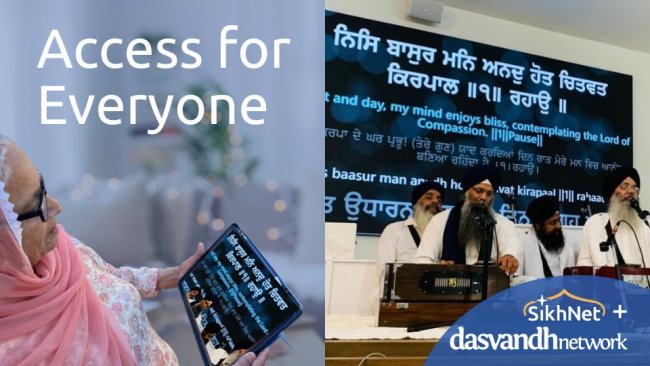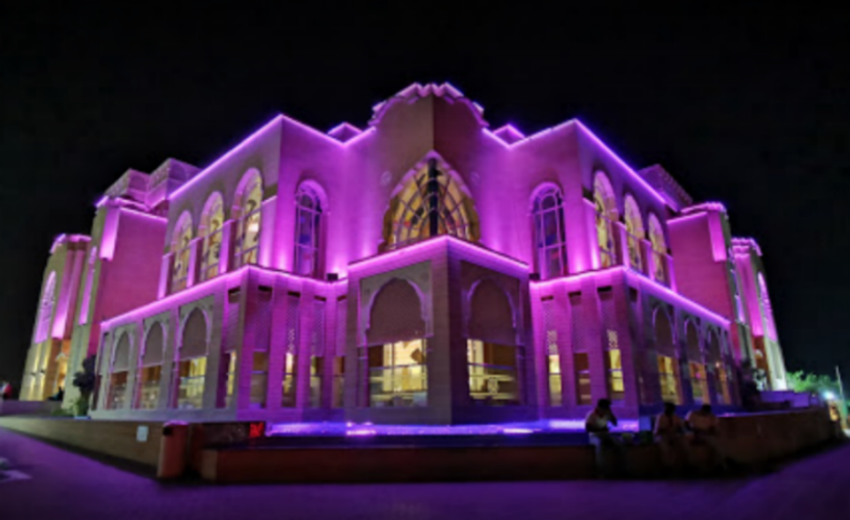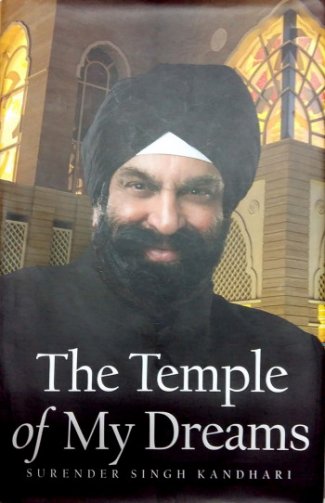The Saga of the Guru Nanak Darbar Gurudwara in Dubai
Book Title: The Temple of My Dreams
Author: Surender Singh Kandhari, Dubai
Published by: Motivate Publishing, Dubai;
Pages: 215; Hardbound, 2018.
Reviewed by: Prof. H.S. Virk, #360 Sector 71, SAS Nagar (Mohali) Punjab.
I had a chance meeting with Surender Singh Kandhari in Mata Sundri College, New Delhi where he was invited to inaugurate the International Seminar on Guru Nanak Dev Ji on December 6, 2019. Sirdar Tarlochan Singh (Ex-MP) introduced me to Kandhari after the inaugural session and we exchanged our biographies before he left the venue. It was a pleasant surprise to find the image of Guru Nanak Darbar Gurudwara, created by the Kandhari family at a cost of 20 million US dollars in Dubai, in the art gallery of Virasat-e-Khalsa at Anandpur Sahib during our family visit on 15th January.
On return from Delhi, I kept this book for reading in a quiet corner of my house. Suddenly, I got a call from Dubai towards the end of December, 2019 inviting me to participate in an International Conference on nanotechnology in mid-February. This invitation motivated me to get introduced with Kandhari family of Dubai and Surender's autobiography came in handy. It is a unique book with three Forewords, followed by nineteen Chapters of Text, one Afterword written by Bubbles Kandhari, and three Appendices, making it a versatile composition as an autobiography.
The blurb of the book informs that Surender Kandhari was born in a well-to-do family of Vijayawada (Andhra Pradesh, India) in 1948. His family was dealing in rubber tyres in Vijayawada and Hyderabad. Surender had the best of education in India, schooling up to 4th grade in St. Mary's High School, Vijayawada, then studying for Matriculation at Hyderabad Public School and then moving on to join Loyola College, Madras. He was a keen sportsman in his college days, playing both Hockey and Cricket. He had the opportunity to study at IIM Ahmedabad but the family wanted him to join AF Ferguson & Co Chartered Accountants office in Bombay. Surender calls his Bombay years as the hard grind of his professional life where he learnt the art of doing business. He joined his father's business enterprise and using his acumen put 'Kandhari Brothers' firm in top gear in tyre business at Hyderabad.
Chapter 5 "The Girl of My Life" is a vivid description of his marriage with Bubbles of Bombay on 30th May, 1970 at the age of 22. It was an arranged marriage with no prior dating with the girl except a meeting arranged by a go-between (vichola) on 6th May, 1970 at the time of betrothal. In Surender's own words: "We got married first and fell in love later. That is the way I put it. She is very adjusting, I am accommodating. I feel for any marriage to last it takes 'two to tango'. We should appreciate each other's qualities and forget the weaknesses because there will always be flaws". In support of his thesis, Surender quotes the dictum from Guru Granth Sahib "ghar me sukh bahar sukh" which means peace in the house brings peace in the world.
In the next two chapters, Surender describes the movement of his family to Dubai in 1976 to start a new venture "Al Dobowi" with five persons as a start up company. With hard work and using fair trade practices and ethics in doing business, Al Dobowi has spread its wings across three continents and ten countries with 2000 people on its pay rolls. These Chapters narrate the struggles of Kandhari family to create a niche for themselves in the UAE society. They are all praise for its people and infrastructure.
Chapter 8 "The Greatest Journey of My Life" opens with a quote from RW Emerson "Happiness is a perfume you cannot pour on others without getting a few drops on yourself". I believe this quote sums up the philosophy of life of Kandhari family, especially Surender and Bubbles. The opening paragraph of this Chapter begins with an appeal: "If you happen to be in Dubai and have the opportunity to visit the Guru Nanak Darbar Gurudwara, do not miss the opportunity. You do not have to be of the faith because the door is open to everyone and it never closes". In my view, this appeal imbibes the spirit of Sikhi of Guru Nanak.
Chapters 8-10 are devoted to the history of creation of Guru Nanak Darbar Gurudwara, the vicissitudes and the saga of struggle of the Kandhari family to create a house of worship for the Sikh community in UAE. According to Surender: "The Gurudwara has been the 'temple of my dreams'. It is more than just the jewel in my crown; it is my citadel, my salute to the glory of God and our obligations to mankind". Surender calls it an epiphany because his grandfather had made a sort of prediction: "One day you had to build a Gurudwara, that is my prayer and my wish, make me that promise".
Chapter 11 describes Surender's love for the golf. He is all praise for this game. In Chapter 12, we have a peep into his mind where he shares the rules of doing business. I will like to quote some of his words of wisdom: "Earn money the right way, do not cheat, do not deceive and do not lie just to make money. When we leave the world nobody is going to talk of our money, only talk will be about what we do for the society and what good deeds we have done which made an impact on people. Every good deed carries a blessing in disguise". Surender often quotes from Gurbani in support of his arguments: "It is best to live in peace and harmony. There is a verse in our holy book, Guru Granth Sahib, which says that there is God in every human being. If you respect humans, then you respect God".
Life is not a bed of roses. Surender has narrated some episodes from his family. He writes that in troubled times, he seeks comfort in a poem written by Bubbles, his beloved wife:
Do not feel let down
When some people betray
To their own plot someday
They will eventually fall prey.
..........
You are a jewel,
Such in a million one you find,
People like you are a blessing to mankind.
In the next three Chapters, Surender writes about his business partnerships in China, South Korea and other countries. He recalls his friendships of School and College days vividly. He recounts his top priorities in life: "On top of my list is hard work. Nothing can replace that. One of the constants in recent years has been my love for the environment and I have dedicated time and effort to issues of overall sustainability".
Chapter 16 is dedicated to Tyres and Batteries. What surprised me is the range and amplitude of Surender's technical know-how in both these fields. As a Scientist, I can vouchsafe for his depth of knowledge in the domain of batteries which are necessary ingredients for a successful businessman. I wish, Indian or Punjab Government can make use of his know-how and talent by appointing him as Overseas Consultant to Industry.
Chapter 18 describes the travels of Surender around the globe for business meetings and participation in World Peace and Inter-Faith Conferences. He organised the first World Interfaith Harmony Conference in Dubai in 2016 which was a great success with participation from 52 overseas delegates and 200 UAE residents. For Surender, religion is not a dogma but a way of life. He explains his concept of sewa and philosophy of life in Chapter 19. In all humility, he writes: "I love to serve God; I love to look after His people; and I love to be a supporter of the noble cause of service to humanity. I am very grateful to God for giving me this opportunity to serve and I shall do it for the rest of my life. I love the concept of sewa and I do it in any way I can. There is nothing evangelical about it and I get as much satisfaction from this indulgence as others do from any activity they enjoy".
Bubbles Kandhari writes her passionate account of life of togetherness with Surender under the sub-title "Love Sans Frontier" in the Afterword of this volume. She pays glowing tributes to Surender in her poetic style. She writes: "What I love about him is that he is very tolerant, ready to listen to any criticism if it is to improve himself. He often says I am his best and worst critic". Guru Nanak Darbar Gurudwara has cemented the bond between the two and they live their life as the quote goes 'two bodies but one soul'.
In Appendix A, more than two dozen acquaintances and friends of Surender pay him glowing tributes. His son, Jasjeev Kandhari, opens the innings and shares his views about his dad frankly in the form of a questionnaire. Anju Kandhari, his daughter-in-law, recounts her experience and adjustment in the family calling Surender as his father in every sense of the word. His Thai friend and classmate in Loyala College, Doosdee Smuthkochoron, reveals many other traits of Surender's character. In my view, this commentary of friends and family members opens a new vista to the life of Surender Kandhari.
Appendix B lists the Charities supported by Kandhari family in UAE and India. Appendix C gives the list of Awards and honours received by Surender Kandhari as a token of his services to the society. The book has about two dozen colour photographs to illustrate the life and work of the author. The most impressive among these photographs are the images of "The Temple of My Dreams", now called the Guru Nanak Darbar Gurudwara in Dubai.







